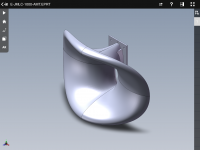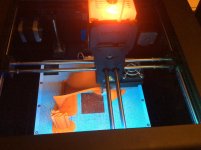Tried a new membrane frame made of oak quarter-round base shoe:

An externally hosted image should be here but it was not working when we last tested it.
Also got me a calibrated microphone a UMIK-1.
These are the first measurements made with that microphone, its on the "old" V4 membrane:

The -15 dB and -18 dB curves are adjusted +3 and +6 dB. respectively.
-13 dB gives 1 W @ 1 meter.
To get the calibration file work with Holm, I had to change the tab separator into a ;.
These are the first measurements made with that microphone, its on the "old" V4 membrane:

The -15 dB and -18 dB curves are adjusted +3 and +6 dB. respectively.
-13 dB gives 1 W @ 1 meter.
To get the calibration file work with Holm, I had to change the tab separator into a ;.
Some measurements on the new oak membrane.
The membrane is essentially a V4 membrane but it got only 17 folds giving 6 ohw instead of 8 ohm.
So first it is V4 versus 17 folds at 25 cm, 50 cm nd 1 meter:



And finally the "17 folds" at 25 cm, 50 cm and 1 meter in one:

The membrane is essentially a V4 membrane but it got only 17 folds giving 6 ohw instead of 8 ohm.
So first it is V4 versus 17 folds at 25 cm, 50 cm nd 1 meter:



And finally the "17 folds" at 25 cm, 50 cm and 1 meter in one:

It is hard to measure in a normal room below 1 kHz I would say, too much room reflections and noise. The longer the distance to the microphone, the worse noise and reflections.
But maybe I should be concerned about the level at 700 Hz.
At a distance of 25 cm above 1 kHz, the distortion level is below -45 dB.
I will post the individual harmonics shortly...
A remainder from a thread at Parts-Express Tech-Talk:
But maybe I should be concerned about the level at 700 Hz.
At a distance of 25 cm above 1 kHz, the distortion level is below -45 dB.
I will post the individual harmonics shortly...
A remainder from a thread at Parts-Express Tech-Talk:
Note that the distortion is displayed relative to the fundamental.
If the fundamental at 1k is 90 dB, and the distortion is 40 dB, then the display shows -50 dB.
If the fundamental at 500 hz is 20 dB lower, ie 70 dB, and the distortion is 40 dB, then the distortion is displayed as -30 dB.
So, if the response is falling, the distortion will look like it is increasing, but it's not.
Ok but in your measurements, is the distortion lifted or is it -30 dB down?
I believe its measurement system specific, how it is displayed.
//
I believe its measurement system specific, how it is displayed.
//
It is hard to measure in a normal room below 1 kHz I would say, too much room reflections and noise. The longer the distance to the microphone, the worse noise and reflections.
But maybe I should be concerned about the level at 700 Hz.
At a distance of 25 cm above 1 kHz, the distortion level is below -45 dB.
I will post the individual harmonics shortly...
A remainder from a thread at Parts-Express Tech-Talk:
for distortion measurement i recommend REW in the end, it gives percentages over whole frequency. but else i like holmimpulse as well 🙂 looking good as well!
i also notice you also are not getting below -55-58 dB dist level it might be the limit of the mic itself
Sorry, I don't understand your question.Ok but in your measurements, is the distortion lifted or is it -30 dB down?
//
Yes of course. For these overall measurements I´m using Holm and the explanation above was for Holm.I believe its measurement system specific, how it is displayed.
//
Yes, REW is better when dealing with detecting distortions sources.for distortion measurement i recommend REW in the end, it gives percentages over whole frequency. but else i like holmimpulse as well 🙂 looking good as well!
But for these overall measurements I´m using Holm.
Yes, that could very well be it! Perhaps I should use the calibrated UMIK to calibrate the Linkwitz modified WM61a!i also notice you also are not getting below -55-58 dB dist level it might be the limit of the mic itself
The 17 folds V4 membrane at 25 cm and -13 dB input power which equals 1,33 W. All measurements are shown with a 1/12 octave smoothing.
THD:
Noise:
2nd:
3th:
4th:
5th:
THD:
An externally hosted image should be here but it was not working when we last tested it.
Noise:
An externally hosted image should be here but it was not working when we last tested it.
2nd:
An externally hosted image should be here but it was not working when we last tested it.
3th:
An externally hosted image should be here but it was not working when we last tested it.
4th:
An externally hosted image should be here but it was not working when we last tested it.
5th:
An externally hosted image should be here but it was not working when we last tested it.
Last edited:
Could you specify at what frequency and which harmonic you mean?30 dB correspond to 3,1% distorsion. Its quite high - what do you think causes this?
//
At 2,2 kHz, THD is at -51 dB, Noise is at -41 dB, 2nd HD at -54 dB and 3th HD at -55 dB relative to the fundamental.
I think there are other frequencies that have higher distortion that could be worth looking into, for example 1,9 kHz and 5,8 kHz for instance.
Right now I'm gonna mount the second "17 folds V4" and measure it.
I think it is slightly better made and assembled; I'm still on a learning curve.
Then we will now if it is the design or the individuals that have flaws.
I think there are other frequencies that have higher distortion that could be worth looking into, for example 1,9 kHz and 5,8 kHz for instance.
Right now I'm gonna mount the second "17 folds V4" and measure it.
I think it is slightly better made and assembled; I'm still on a learning curve.
Then we will now if it is the design or the individuals that have flaws.
wel the umik is a WM61a as well as far as i know. the linkwitz mod was primairely to be able to use it with higher spl as far as i know. i got one still as well. came out really nice only used the electret aluminium pipe and an xlr connector, i tapperd the end of the pipe a little dropped in the electret, and glued the whole pipe into an neutrik XLR you got an instant smooth long mike with only 3 items 🙂 (als put the pipe in a drill chuck and use some sanpaper to make a nice brushed finish, takes only 1 minute)
somewhere in the cable i added the battery for the mod.
it should be nice to calbrate distortion from the umik against a B&K or any other good calbrated mic.
still the umik is verry usefull to see real problems in the distortion. if your total THD is -55 it is really good. i used rew after such measurements and i got readings as low as 0.08%(just a few frequencies) on a esl so i guess the mic is capable, but holm is a bit hard to get a good readout. it does give you an idea of where the problems are, thats why i use holm as well. just simple and fast.
somewhere in the cable i added the battery for the mod.
it should be nice to calbrate distortion from the umik against a B&K or any other good calbrated mic.
still the umik is verry usefull to see real problems in the distortion. if your total THD is -55 it is really good. i used rew after such measurements and i got readings as low as 0.08%(just a few frequencies) on a esl so i guess the mic is capable, but holm is a bit hard to get a good readout. it does give you an idea of where the problems are, thats why i use holm as well. just simple and fast.
Last edited:
Yes, I got four of those already.wel the umik is a WM61a as well as far as i know. the linkwitz mod was primairely to be able to use it with higher spl as far as i know. i got one still as well. came out really nice only used the electret aluminium pipe and an xlr connector, i tapperd the end of the pipe a little dropped in the electret, and glued the whole pipe into an neutrik XLR you got an instant smooth long mike with only 3 items 🙂 (als put the pipe in a drill chuck and use some sanpaper to make a nice brushed finish, takes only 1 minute)
somewhere in the cable i added the battery for the mod.
Yes, it would.it should be nice to calbrate distortion from the umik against a B&K or any other good calbrated mic.
The aim for these measurements was to see the effect on the 5 kHz hump by using the quarter-round base shoe and thus a narrower membrane. The hump I got instead from 13 kHz and up is easier EQ:ed.still the umik is verry usefull to see real problems in the distortion. if your total THD is -55 it is really good. i used rew after such measurements and i got readings as low as 0.08%(just a few frequencies) on a esl so i guess the mic is capable, but holm is a bit hard to get a good readout. it does give you an idea of where the problems are, thats why i use holm as well. just simple and fast.
I'm printing ejmlc-1000 horn for AMT 25120 (Aurum Cantus) to see how it performs.
oh wow 🙂 i got a cnc and all but still no 3dprinter(mainly to expensive to run unless i get a pellet extruder i wont get one yet) :0 looks very nice! we live in good times!! for Diy!
- Status
- Not open for further replies.
- Home
- Loudspeakers
- Planars & Exotics
- Yet another DIY AMT

